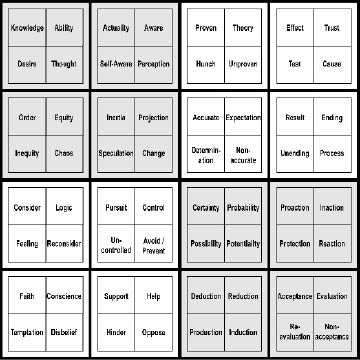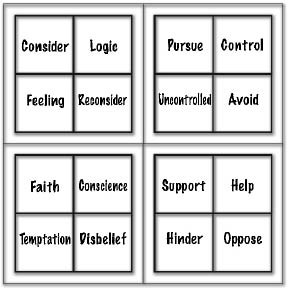Other Character Dimensions
When authors describe their characters, they are often asked to state a character's motivations. A common reply might be, "The character Jane wants to be president." Often that is accepted as a valid motivation. In fact, becoming president is Jane's Purpose, not her motivation. Her motivation may be that she felt no control over her life as a child. Or she might be motivated by a love of the natural world, hoping to start a national conservation plan. She might be motivated by a desire for an equal rights amendment.
Just knowing what her purpose is does not tell us anything about what Jane is driven by but only what she is driven toward. Any of the stated motivations would be enough to explain Jane's purpose of becoming president. Conversely, if Jane's motivation were the first example--a lack of control over her life as a child--several different purposes might satisfy that motivation. She might become a schoolteacher, a drill sergeant, or a religious leader. Clearly, motivations do not specifically dictate purposes, nor are purposes indicative of any particular motivations.
Step into the Fourth Dimension....
In Dramatica, we refer to Motivation as a Character Dimension. Often it is said that characters must be three-dimensional to seem like real people. Dramatica sees four dimensions as necessary to flesh out a character. Motivations and Purposes are the first and last dimensions, but that is not enough. Motivation gives a character the force to move, Purpose gives a character a direction in which to move. But how is he going to get to where he wants to go? For this, he needs a Methodology, which is the third dimension of character. Methodologies describe the kinds of approaches a character might use in its efforts to achieve its purposes.
This might seem like enough dimensions. After all, we have a beginning (motivation), a middle (methodology), and an end (purpose). Still, there is one remaining dimension lacking: Evaluations. Evaluations are the standards by which characters measure their progress.
All right, Buddy... Where's the conflict?!
As an example of the concept of Evaluation, imagine two business partners who share motivations, methodologies and purposes. They might agree on what drives them (a motivation to be independent), what they want to achieve (a purpose of creating a thriving business), and how to achieve that (word-of-mouth advertising as a methodology).
However, they might argue about why sales are up but satisfaction is low because their evaluations suggest different reasons. If one evaluates success based on gross sales, he might argue that their word-of-mouth methodology brings in more business because their prices are good. If the other evaluates based on customer satisfaction, he might argue that repeat business is non-existent because of poor customer satisfaction. As a result, the two partners argue all the time, even though they agree in all three dimensions of Motivation, Methodology, and Purpose.
Difficulties can arise between characters in any one of the four dimensions, even though they might agree in one or more of the other dimensions. In short, characters are never fully developed unless they are represented in all four dimensions, and they may come into conflict over any combination of Motivations, Methodologies, Means of Evaluation, or Purposes.
The Sixty-Four-Element Question
Each of the character dimensions contains sixteen Elements, as we have already seen with Motivations. Each character dimension is referred to as a Set of Elements. All four Sets come together to create a Chess Set (because of its eight by eight grid) as illustrated below:
Purpose Set Evaluation Set

Motivation Set Methodology Set
A good way to get a feel for the content of and relationships between character dimensions is through the Archetypal Characters. When we superimpose the Archetypal Characters onto the character Elements, an "archetypal pattern" appears. Let's begin with the Motivation Set:

